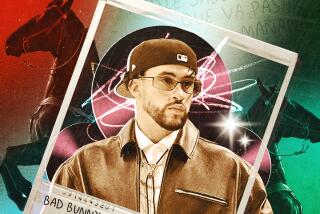Review: East London built over for sport in ‘Ghost Milk’
Ghost Milk
Recent Adventures Among the Future Ruins of London on the Eve of the Olympics
Iain Sinclair
Faber and Faber: 406 pp., $28
Until lately Iain Sinclair’s work was little known in the U.S. In the U.K., he came to readers’ attention with “Lud Heat” (1975). A mixture of verse and prose, it described his experience as a manual laborer for an East London parks department, focusing on Wren’s contemporary Nicholas Hawksmoor, architect of many London churches. “Lud Heat” was heavily drawn on by Sinclair’s friend Peter Ackroyd for his own much-admired novel “Hawksmoor.”
“White Chappell, Scarlet Tracings” (1985), Sinclair’s first novel, was an unconventional explosion of language and ideas riffing off Sherlock Holmes and the Ripper myth. This in turn inspired Alan Moore’s graphic novel “From Hell,” filmed by the Hughes brothers in 2001 starring Johnny Depp. It seemed for a while that Sinclair would remain a somewhat obscure writer’s writer until 1991, when his novel “Downriver” was nominated for the (Man) Booker, receiving the James Tait Black Memorial Prize and the Encore Award.
In 1997, Sinclair’s “Lights Out for the Territory” became a bestseller. In style these thematically connected essays read a little like an urban Thoreau and echoed Stevenson and 19th century “new journalism.” In its discursive good humor, it’s also reminiscent of the work of Jerome K. Jerome. A series of narratives reflecting Sinclair’s walks through London, the essays established a form in which place, identity, observation and myth were woven back and forth in time and space, creating a thick tapestry of unique associations. Here, as elsewhere, Sinclair is chiefly interested in the “reforgotten,” the homeless, the eccentric and the outlawed.
His idiosyncratic technique grew increasingly sophisticated. By “London Orbital” (2002), when he walked around the infamous M25, London’s new ring road, he identified “England’s biggest car park” with Thatcher’s ersatz visions of an imperial Tory utopia. In “Hackney, That Rose-Red Empire,” he wrote affectionately of his home borough (though not affectionately enough to please the mayor).
Meanwhile he made feature films for Channel 4, employing a similar style against a broader geographical background. His first (with Chris Petit), “The Cardinal and the Corpse,” factualized certain fictions and fictionalized real people such as Alan Moore, Martin Stone, Derek Raymond, Emanuel Litvinoff and gangland associates of the murderous Krays. “London Orbital” was filmed as the book was written. Other films included “The Falconer” and “Asylum.” Like his books, Sinclair’s films display a distinctive, poet’s style.
For Sinclair, history is about ordinary people, artifacts, life, best represented by artisan’s cottages, suburban Tudor, red-brick terraces, town halls, factories, shops, churches, banks, hospitals, industrial canals, rail tracks, abandoned docks and forgotten rivers:
“Everything begins with the fact of the river, the Lea and its tributaries. Like a wig of snakes. A dark stream sidling, fag in mouth, towards the Thames at Bow Creek; foam-flecked, coot-occupied, enjoying its drench of industrial pollution, cars with the ambition of becoming submarines, skinned bears, over-excited urban planners.”
“Ghost Milk” mourns how, conceived in idealism, vulgarized by greed, London’s recent Olympic Games were hijacked by crass commercial and political interests; East London’s layers of history were buried by developers hoping to increase the value of their swampy real estate. It begins in familiar London territory, first encountered in “Lud Heat,” remembering some of the same friends while tracking the River Lea back from where it enters the Thames. Unexpectedly, the book ends in California — by way of Manchester, Berlin and, following a trail partly blazed in the largely American Southwest-set “Asylum,” Austin, Texas.
Inevitably, for an author admired by so many distinguished contemporaries, Sinclair was spotted by Tom Staley, the extraordinary director of the University of Texas at Austin’s Harry Ransom Center. The university purchased Sinclair’s papers for its unrivaled modernist collection and invited him to visit in 2011. Slightly bemused by being taken so seriously, impressed by the good manners of his hosts, admiring a collection that contains not only Conrad and James but De Niro’s suits and Houdini’s chains, Sinclair writes about this in a kind of appendix at the end of “Ghost Milk.”
In Austin, Sinclair gave amiable interviews, was wined and dined, received an unfamiliar level of respect, walked a little, and was overwhelmed by generous Texan hospitality. With flights stranded by volcanic action in Iceland, Sinclair paid a longer visit than planned to San Francisco, which he celebrates here as a city of poets and bookstores, whose literary and film references continue to inspire him.
Expanding his psychic territory, Sinclair found Manchester and Berlin almost as exotic as Hollywood. The filmmaker in him, however, was especially excited by California. His references to film here are unforced, second nature. But in the end Sinclair’s soaring, original and wonderful prose is what carries the reader on a vivid journey through unfamiliar parts of London and makes “Ghost Milk” such an astonishingly good read.
Moorcock is the award-winning author of many books, including “Mother London,” the Elric saga and, most recently, “London Peculiar and Other Nonfiction.”
More to Read
The biggest entertainment stories
Get our big stories about Hollywood, film, television, music, arts, culture and more right in your inbox as soon as they publish.
You may occasionally receive promotional content from the Los Angeles Times.






